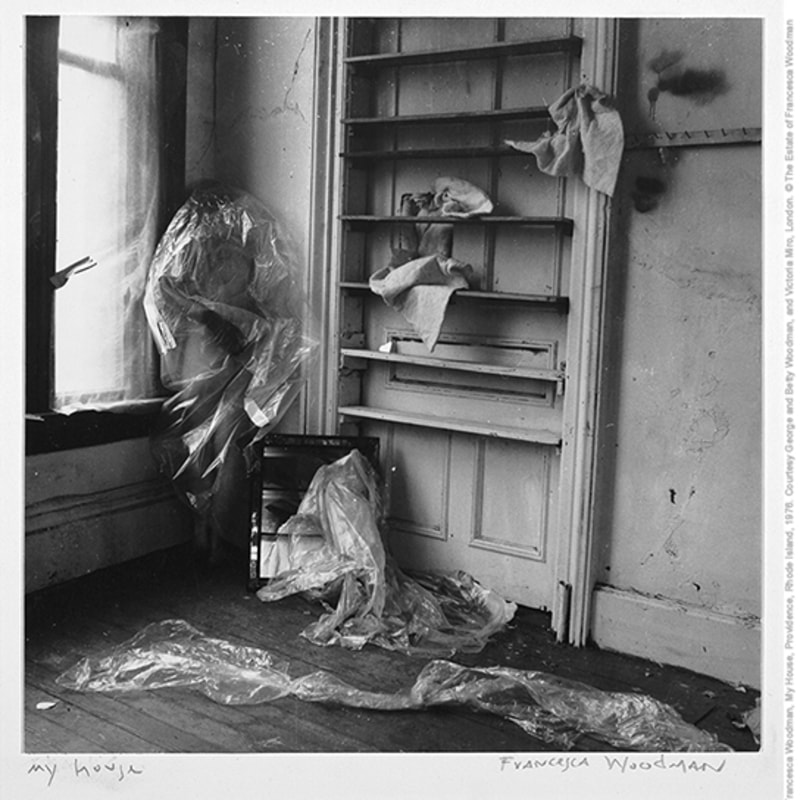From January to February 2017, Sadie Coles HQ presents Room, an exhibition that brings together stand-alone installations and photographic works by female artists. Room shows how domestic space – historically a ‘female’ sphere of activity – has been imagined by artists from the late twentieth century to the present. The show reflects the multiple, often concurrent, roles of the room – whether as interior space or enclosing structure, as a metaphor for the psyche or a social construct. Room features artists who have envisaged the room as a psychological, erotically-charged space, as well as those who have explored the structural and aesthetic properties of the domestic unit. In many cases, the different attributes are inseparable: the room is at once a psychical and physical place.
Sarah Lucas’s installation Chuffing Away to Oblivion (1996), which was first shown as part of her exhibition ‘The Law’ (St John’s Lofts, Clerkenwell, 1997), represents an ‘enclosure for smoking’. It is a flimsy cabin crafted from a timber frame and brown paper, lined on the insides with tabloid newspapers. Out of mundane materials, the artist has constructed a nicotine-stained den papered with tabloid soft porn – a masculine environment made by a female artist as a gesture of a brash appropriation. In the same year, Andrea Zittel devised a different kind of personalised environment in her seminal series of Escape Vehicles (1996), each based on the cabin-like steel module of a mobile home. The version in the exhibition is a floatation tank – a hypothetical yet functioning survival capsule, complete with an underwater sound system, twin-spa light system, climate control and insulation. By contrast, in Klara Lidén’s Teenage Room (2009), functionality is stripped away to leave psychological residues: the retreat of an adolescent is imagined as a stark, scaffold-like ‘bone structure’ or stage set.
Throughout the exhibition, the room represents a liminal space – the intersection of private and public worlds; a nexus of personal associations and wider social realities. Louise Bourgeois’s Cell XVII (Portrait) (2000)presents a single head – an elongated portrait – inside a glass-fronted cage. The structure is both protective and imprisoning, a threshold and a straitjacket. In Heidi Bucher’s Herrenzimmer (1977-79), one of her largest ‘room skin’ installations, the interior surfaces of her father’s study are imprinted on latex sheets which hang like giant pieces of parchment. Personal memory is also at the heart of Andra Ursuta’s T, Vladimirescu Nr. 5, Kitchen (2013), which recreates a room from her childhood home as a toy-like miniature encased in glass. Marianne Vitale’s Double Decker Outhouse (2011) uses reclaimed lumber to form a closed and prisonlike entity, offsetting Minimalist aesthetics with sinister and absurdist undertones. In Marvin Gaye Chetwynd’s The Folding House (2010), a communal structure made of recycled elements dissolves the line between interior and exterior, functioning both as a utopian enclosure and a stage. In the work of Rachel Feinstein, domestic architecture becomes a brimming toy-box of clichés and hallmarks, out of which the artist constructs a deceptively playful – even pop-up – scenery.
These diverse works reflect the ways in which the room has been miniaturized, multiplied or fragmented. Running through the works is a consistent focus on the room as a tangible entity, rooted in a specific place and time, and yet charged with emotional and imaginative resonance. This specificity is reflected in four series of photographic works by Nan Goldin, Joanna Piotrowska, Penny Slinger and Francesca Woodman, in which particular rooms have been frozen in time by the camera (a device which itself originated as a room: the sealed chamber of the camera obscura). For each of these artists, the real-life room becomes a mode of self-portraiture, an expression of memory, and a springboard for fantasies or follies. In Slinger’s collages, the photographed room is literally overlaid by imaginary elements in the form of cut-outs. Mediating between the subjective self and external reality, the rooms in these works recall Charlotte Perkins Gilman’s ground-breaking short story ‘The Yellow Wallpaper’ (1892), in which the narrator is closeted in an oppressive chamber whose lurid yellow wallpaper becomes a mirror of her unravelling mental state – alternately a fixation and mirage, a barrier and a transparent otherworld. Within and between the different works in Room, the domestic interior is examined (as in Gilman’s story) in many guises – as a place of retreat, an index of style, a site of display, a metaphor for the mind, an expression of the mundane, or a vessel for the uncanny.
Room will tour to the Mead Gallery, University of Warwick, Saturday 06 May – Saturday 24 June 2017
Artists in Room include Louise Bourgeois, Beverly Buchanan, Heidi Bucher, Marvin Gaye Chetwynd, Rachel Feinstein, Nan Goldin, Klara Lidén, Hilary Lloyd, Sarah Lucas, Joanna Piotrowska, Penny Slinger, Andra Ursuta, Marianne Vitale, Francesca Woodman and Andrea Zittel. Room is curated by Laura Lord.
Image: Francesca Woodman, My House, Providence, Rhode Island, 1976. Courtesy George and Betty Woodman, and Victoria Miro, London. © The Estate of Francesca Woodman
